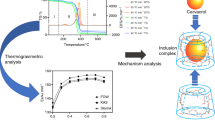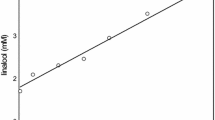Abstract
Supercritical fluid technology (SFT) offers many advantages as a potential complexation method compared to the conventional kneading technique. Its applicability to processess in which solvents are not required is a significant benefit. The main aim of this study was to evaluate, experimentally and computationally, the applicability of SFT in the preparation of β-cyclodextrin complexes with two selected essential oils, namely, carvacrol and linalool. Preparation of the complexes was performed using kneading and SFT method. Several methods were used in the solid-state characterization. These include thermal analysis, powder X-ray diffraction, Fourier transform infrared spectroscopy, and solid-state nuclear magnetic resonance. Besides, molecular dynamics simulations of all studied systems were conducted in order to have a deeper and a detailed insight, at the atomic level, of the nature of the two used techniques. Despite all the advantages of SFT, better results of guest molecule entrapment inside β-cyclodextrin were obtained with the kneading method. The percentages of oil content for linalool samples were 70 ± 14 and 84 ± 9% for SFT and kneading method, respectively, while the drug content values for carvacrol samples were 67 ± 15 and 81 ± 13% for SFT and kneading method, respectively. Interestingly, simulation results were in perfect agreement with the experimental ones and, moreover, they provided a plausible explanation for the obtained results. In conclusion, our results showed that the SFT was unsuccessful in enhancing the stability of the studied complexes contrary to that of the conventational kneading method, and in both cases, molecular dynamics simulations correctly predicted the expected outcomes.










Similar content being viewed by others
References
Numanoğlu U, et al. Use of cyclodextrins as a cosmetic delivery system for fragrance materials: linalool and benzyl acetate. AAPS PharmSciTech. 2007;8(4):34–42.
Adrian P, Mircea B, Calin GF. NMR spectroscopic characterization of β-cyclodextrin inclusion complex with vanillin. J Phys Conf Ser. 2009;182(1):012013.
Shweta K, Swarnlata S. Topical herbal therapies an alternative and complementary choice to combat acne. Res J Med Plants. 2011;5:650–69.
El-Kadi A, Kandil O. Effect of Nigella sativa (the black seed) on immunity. Bull Islam Med. 1986;4:344–8.
Andrade MA, et al. Essential oils: in vitro activity against Leishmania amazonensis, cytotoxicity and chemical composition. BMC Complement Altern Med. 2016;16:444.
Basholli-Salihu M, et al. Phytochemical composition, anti-inflammatory activity and cytotoxic effects of essential oils from three Pinus spp. Pharm Biol. 2017;55(1):1553–60.
Andrade TA, et al. Physico-chemical characterization and antibacterial activity of inclusion complexes of Hyptis martiusii Benth essential oil in β-cyclodextrin. Biomed Pharmacother. 2017;89:201–7.
Rodrigues LB, et al. Anti-inflammatory activity of the essential oil obtained from Ocimum basilicum complexed with β-cyclodextrin (β-CD) in mice. Food Chem Toxicol. 2017;109(Pt2):836–846. https://doi.org/10.1016/j.fct.2017.02.027.
Locci E, et al. 13C-CPMAS and 1H-NMR study of the inclusion complexes of β-cyclodextrin with carvacrol, thymol, and eugenol prepared in supercritical carbon dioxide. Chem Biodivers. 2004;1(9):1354–66.
Schwertfeger F, Zimmermann A, Krempel H Use of inorganic aerogels in pharmacy. 2001. Google Patents.
Krukonis V. Supercritical fluids: their proliferation in the pharma industry. Eur Pharmaceutical Contractor (EPC). 1998 (in press).
Martín A, Cocero MJ. Micronization processes with supercritical fluids: fundamentals and mechanisms. Adv Drug Deliv Rev. 2008;60(3):339–50.
Pasquali I, Bettini R, Giordano F. Supercritical fluid technologies: an innovative approach for manipulating the solid-state of pharmaceuticals. Adv Drug Deliv Rev. 2008;60(3):399–410.
Zougagh M, Valcárcel M, Ríos A. Supercritical fluid extraction: a critical review of its analytical usefulness. TrAC Trends Anal Chem. 2004;23(5):399–405.
Pasquali I, Bettini R. Are pharmaceutics really going supercritical? Int J Pharm. 2008;364(2):176–87.
Yoshida VMH, et al. Supercritical fluid and pharmaceutical applications. Part I: process classification. Afr J Pharm Pharmacol. 2016;10(9):132–44.
Discovery Studio. Accelrys Inc.: San Diego, CA, USA; 2017
Wu G, et al. Detailed analysis of grid-based molecular docking: a case study of CDOCKER-A CHARMm-based MD docking algorithm. J Comput Chem. 2003;24(13):1549–62.
Momany F, Rone R. Validation of the general purpose QUANTA ®3.2/CHARMm® force field. J Comput Chem. 1992;13(7):888–900.
Brooks BR, et al. CHARMM: the biomolecular simulation program. J Comput Chem. 2009;30(10):1545–614.
The PyMOL Molecular Graphics System, version 0.99rc6, Schrödinger, LLC.
Humphrey W, Dalke A, Schulten K. VMD: visual molecular dynamics. J Mol Graph. 1996;14(1):33–8.
Banerjee A, et al. Molecular bases of cyclodextrin adapter interactions with engineered protein nanopores. Proc Natl Acad Sci. 2010;107(18):8165–70.
Mark P, Nilsson L. Structure and dynamics of the TIP3P, SPC, and SPC/E water models at 298 K. J Phys Chem A. 2001;105(43):9954–60.
Beckman EJ. Supercritical and near-critical CO2 in green chemical synthesis and processing. J Supercrit Fluids. 2004;28(2–3):121–91.
Feller SE, et al. Constant pressure molecular dynamics simulation: the Langevin piston method. J Chem Phys. 1995;103(11):4613–21.
Ryckaert J-P, Ciccotti G, Berendsen HJC. Numerical integration of the Cartesian equations of motion of a system with constraints: molecular dynamics of n-alkanes. J Comput Phys. 1977;23(3):327–41.
Menezes PP, et al. Inclusion complex of (−)-linalool and β-cyclodextrin. J Therm Anal Calorim. 2014;115(3):2429–37.
Al-Sheibany IS, Kasim HK, Amal SA. Isolation and identification of volatile oils from Iraqi Thyme (Thymbra Spicata) and study the antimicrobial activity. Natl J Chem. 2005;18:289–98.
Galvão JG, et al. β-cyclodextrin inclusion complexes containing Citrus sinensis (L.) Osbeck essential oil: An alternative to control Aedes aegypti larvae. Thermochim Acta. 2015;608:14–9.
Menezes PdP, et al. Kinetic and physical-chemical study of the inclusion complex of β-cyclodextrin containing carvacrol. J Mol Struct. 2016;1125(Supplement C):323–30.
Abarca RL, et al. Characterization of beta-cyclodextrin inclusion complexes containing an essential oil component. Food Chem. 2016;196(Supplement C):968–75.
Obaidat R, Al-Shar’i N, Tashtoush B, Athamneh T. Enhancement of levodopa stability when complexed with β-cyclodextrin in transdermal patches. Pharm Dev Technol. 2016;1:1–12. https://doi.org/10.1080/10837450.2016.1245319.
Funding
The authors acknowledge Deanship of Research at Jordan University of Science and Technology (JUST) for funding this work with grant number (113/2011).
Author information
Authors and Affiliations
Corresponding author
Ethics declarations
Conflict of Interest
The authors declare that they have no conflict of interest.
Rights and permissions
About this article
Cite this article
Al-Shar’i, N.A., Obaidat, R.M. Experimental and Computational Comparative Study of the Supercritical Fluid Technology (SFT) and Kneading Method in Preparing β-Cyclodextrin Complexes with Two Essential Oils (Linalool and Carvacrol). AAPS PharmSciTech 19, 1037–1047 (2018). https://doi.org/10.1208/s12249-017-0915-x
Received:
Accepted:
Published:
Issue Date:
DOI: https://doi.org/10.1208/s12249-017-0915-x




